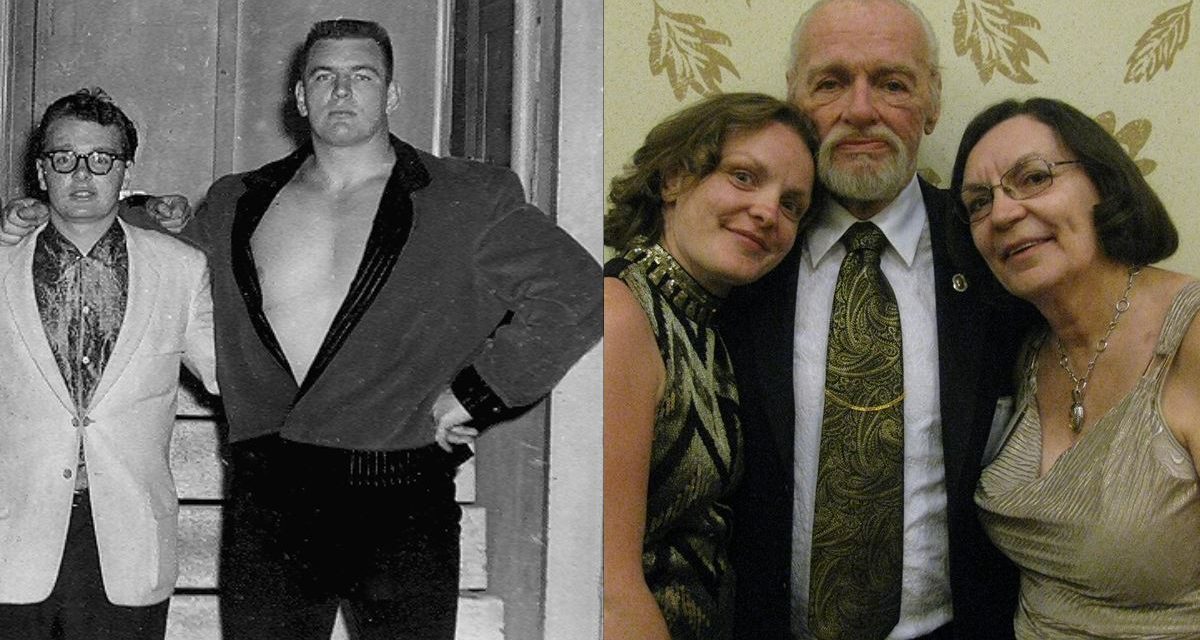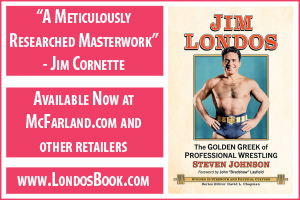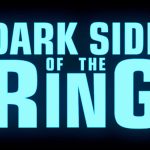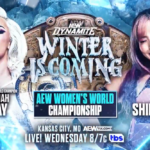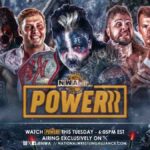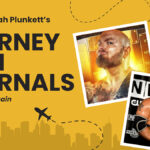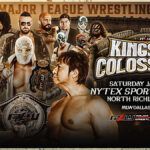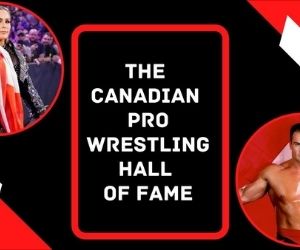It was my Auntie Gwen’s fault. And the fact that my family’s television only had two channels – five and 10.
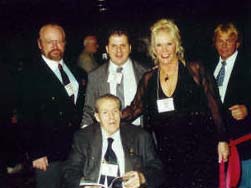
Bob Leonard, left, with Ross and Bruce Hart, their father Stu, and Penny Banner. (Photos courtesy Bob Leonard).
My Aunt, having much better cable, took pity on us and would record a variety of programs on video and then mail them to us from Trail, B.C.
I remember being seven years old and opening one of those precious brown, paper packages. As I inserted that black piece of plastic into the VCR, I had no idea that my life was going to change drastically.
See my Aunt had included a wrestling program on one tape, Saturday Night’s Main Event. She probably thought nothing of it. Probably thought my dad or my younger brother would find it entertaining.
I can still tell you everything that was on it.
Because I still have that tape.
From that day on, I knew what I wanted to do with my life. I had found my passion and I was determined to make a career writing about it.
This hasn’t been easy. My interest in wrestling was often ridiculed. In elementary school, my teachers and classmates could never understand why I, a student getting A’s in all my classes, was wasting my time on something that to most people, wasn’t even a real sport.
“Such a bright girl, I wonder when she’ll grow out of this wrestling thing,” they’d scoff.
Oh yeah, I guess I forgot to mention I’m female. It’s every mother’s dream to have a daughter obsessed with wrestling.
“Mom, I’m going to be a wrestling journalist,” I would shout out with exuberance.
“That’s nice, Jamie, now pass the (insert random vegetable here),” my mother would sigh.
One person that never sighed, laughed, judged, shook his head or made me pass him vegetables was Bob Leonard.
I became of aware of Bob’s existence when I was 13 years old. I was going through what I thought was a typical teenage crisis. Bret “The Hitman” Hart, who just happened to be one of my favorite wrestlers, was signing autographs in Regina, a two-hour drive from where I lived. My parents were too busy with work to drive me.
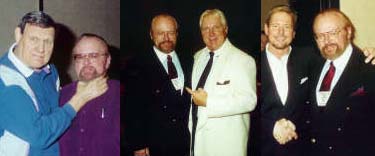
Bob Leonard with, from left, Killer Kowalski, Bobby Heenan and Roddy Piper.
I was distraught.
My complaints carried on as I was cutting the grass of a family friend, Herb Tempel. He was highly amused by my grumblings.
“Jamie, why are you so upset?” he asked.
“Because my life is over,” I answered matter of factly.
After he had finished laughing. I told him my dilemma.
“Maybe my friend Bob Leonard can help you,” he said.
“Who is Bob Leonard?” I asked.
It seemed like a simple question.
Herb told me that he and Bob had worked together at the Medical Care Insurance Commission and that Bob also had a penchant for wrestling. Herb called Bob up and before I knew it, I had an autographed 8 x 10. I still store it in a photo album.
To Jamie
Bret “the Hitman” Hart
Once I learned of Bob’s existence, he became an obsession of mine. A grownup who liked wrestling. How remarkable!
As I grew older, my interest in wrestling didn’t wane and neither did Bob’s presence in my life. I made a habit of implementing wrestling into any academic assignment I could, right into university. Bob was always just a phone call or a coffee away if I needed a story idea or a contact.
But one thing has continued to perplex me. I’ve been wanting to come up with my own answer to the question, “Who is Bob Leonard?” every since I uttered it years ago. Here is my chance.
* * *
That voice.
You have to start there.
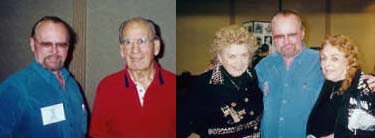
Bob Leonard with, from left, Lou Thesz, and Mae Young and The Fabulous Moolah.
If you’ve ever been lucky enough to meet Bob, it is a sound you won’t soon forget.
If you haven’t, it’s an unmistakable deep/throaty/growl/purr that has the power to command attention, entertain, instill wisdom yet still comfort.
Starting in the mid-1960s, it was also the voice heard booming through arenas announcing matches at countless, live Stampede Wrestling events across Western Canada and occasionally sharing the microphone with legendary host Ed Whelan, on the TV program, Stampede Wrestling From Calgary.
A show that creates ripples of nostalgia for Canadian wrestlers and fans alike because for many that was their preschool, their introduction to the world that is wrestling.
Careers were inspired. Fans were transfixed.
For some, it was a time when wrestling was still prime, or still good as my Dad would say. A simpler, more basic time. Bob remembers it well.
“There were more actual wrestling holds, counter holds and counter moves involved in it,” he reminisced. “It was a lot more mat based than the high flying stuff of today. Certainly wrestling for many years has had the heroes and the villains, it’s the old good vs. evil battle. But there was a lot more wrestling.”
We’re having coffee in the Leonard household. It’s my first visit to the Spanish-style home. I was expecting to walk in the doors and see a wrestling ring set up, but instead I’m still trying to come to grips with all the Tiffany lamps that are interspersed with the rest of Bob’s eclectic décor. Antiques. Asian sculptures in the corners. Am I really in Bob Leonard’s house?
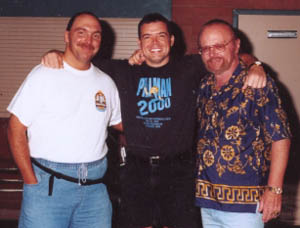
John Cozman, Steve Hooper and Bob Leonard have a “board meeting”. (Courtesy Steve Hooper).
Several cups later and we’ve delved head first into the Stampede era, a time free of million dollar egos and salaries. It was a time of carpooling to venues instead of taking private jets. Rookies took home approximately $300/week. Guys with a little more experience maybe got $400-450/week for their bumps and bruises. Some big names drew as much as $3,000/week when arena business was hot.
The fans were different too. Today I go to a wrestling show and I watch them heckle the wrestlers. They get right in the face of the heels. Profanity spills out of the young and old. Out of their mouths and their signs.
I remember the days of Hulk Hogan. The early ’80s. That’s when I started watching. Fans would cheer and actually smile. I remember it being such a big deal to see Hogan live and, it may be silly, but I was actually afraid of his opponents.
And when I was a kid, no one would dare yell out, “Fuck you, Hogan!”
The magic, the fear, appears to be gone.
“Ah, fan emotions back then,” sighed Bob. “There were guys who could play them like a violin. The fans were much deeper into what they believed. A lot of them knew, ‘Well I think this is somehow rigged, but I’m not sure.’ They were willing to suspend that and just go out and enjoy it for what it was.”
Bob ponders if the heels of today have the depth of character that the legends did. He gives a throaty guffaw as he cites Abdullah the Butcher as a stellar example.
Abdullah, born Larry Shreeve, was a 360-pound native of Windsor, Ontario, who wrested with Stampede from 1969 to the early 1970s, and even into the ’80s. One of his gimmicks was the gruesome carving up of his opponent’s scalp with foreign objects. Hence his nickname.
“Ab was really unpredictable,” remarked Bob. “He would move toward a group of fans and they just scattered. In Japan, it looked like a cattle stampede. They were terrified of him, the look, the mannerisms, everything.”
When Bob wasn’t making his presence known on the mike, he would often don the black and white stripes and officiate matches. That’s how his wrestling career escalated. If a position needed filling, no matter what it was, Bob would accept, because to him this was truly living.
He had succeeded in finding the perfect balance of incorporating his passion into his everyday life. From 9-5 he was dedicated to his “real” job, various public relations endeavors with the Government of Saskatchewan. But after the final punch out, it was time for the real punches, the ones that happened in the ring.
Born on October 16, 1941 in Olds, Alberta, the only child of Bill and Lillian Leonard, Bob had been bitten by the wrestling bug young. The emergence of television in the 1950s allowed him to watch Frank Tunney’s show. Tunney, one of the continent’s major wrestling promoters back in the day, ran his promotion out of Maple Leaf Gardens in Toronto, and it was broadcast across Canada.
The Leonard family were mainly city dwellers making their home in such locales as Calgary and Edmonton, before coming to Regina when Bob was only five years old. Bob’s first live show, a Stampede Card out of Calgary headed up by the legendary and the late, Stu Hart, was at Regina’s Exhibition Auditorium.
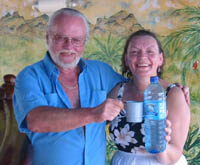
Bob & Winnie (Courtesy Steve Hooper).
“I had become infected with this disease,” explained Bob with a laugh. “I’ve still got it, you never lose it.”
At the time another passion was emerging in young, Bob, a ferocity with words.
In fact, his prose is what got his foot or rather his pen in the door of professional wrestling in the first place.
It was 1957. Bob was becoming a regular attendee, hanging around backstage when the Stampede wrestling shows came to town. During one evening, he was approached by one of the headliners, George Scott. Scott asked Bob, of all things, if he happened to be any good at the written word.
“I said, ‘Well not bad,'” recalled Bob, as he took a drag of his Matinee Slims 100s cigarette. “George said, ‘A friend of mine in North Bay, Ontario is looking at starting the first all Canadian wrestling magazine. He’s looking for someone out here to report on Saskatchewan, would you be interested?’ I said, ‘Sure, I’ll give it a try.'”
Bob sent a couple of pieces down East. After two issues the publication went belly up. Undeterred and with his soles plenty wet, Bob contacted Nat Loubet, an editor at Ring Magazine in New York. The magazine was considered to be the Bible of boxing and wrestling magazines at that time, however the scales of page content were tipped heavily on the boxing side.
Bob went on to publish several pieces with the magazine and as wrestling grew, he witnessed the birth of its sister magazine, Ring Wrestling, a publication dedicated entirely to wrestling, and Loubet was made Editor-in-chief.
Concurrently, Bob also worked as a monthly columnist and a feature writer for The Wrestler, a British magazine. He also found the time to freelance for wrestling publications in Japan, Australia and the United States.
But what is a story without pictures?
Through his adventures in pages, Bob was always being asked to provide accompanying photos.
“I thought, well, I’ll have a go at that,” he said simply. “I’d always had a little camera because my mother was a fair photographer. I picked up a rig of my own and started in ’62 I think it was shooting pictures essentially in-ring action stuff. I learned by doing, I never took a course.”
His self-taught motivations has lead to an amassed collection of “at least 90 million negatives,” according to Bob. A treasure trove of perfectly timed photos that is envied and well sought out.
“Years ago, I’m not sure Bob would have thought of it or not, taking pictures like he did, and the thousands and thousands of pictures he took and how they are coming back now,” commented John Cozman, a close friend of Bob’s who is better known by his wrestling persona, Principal Richard Pound. “Everyone is writing a book. Everyone needs a biography done on them and they need pictures. Well, who has pictures? Bob can pull up pictures of anybody and everybody.”
* * *
As the 1980s approached, a wrestling promotion by the name of World Wrestling Federation owned by Vince McMahon annihilated most of the smaller wrestling promotions. Stampede managed to last (with a brief break) until the end of 1989, but it was an uphill battle.
Through his connections with Stu Hart, Bob landed a job as a local promoter with the WWF, making him responsible for shows that came to Regina and Saskatoon. The lucrative position would continue until 1993.
“It was up to me to publicize the card, handle the advertising and arrange interviews for the talent,” he explained. “Really just getting the fact that the WWF was coming to town out there in front of the public as much as possible.”
And the crowds came willingly.
The ’80s were a time when Hulk Hogan (Terry Bollea) was huge. Droves of fans, including myself, had dubbed themselves, “Hulkamaniacs,” draped themselves in his signature red and yellow colors and believed that they could be like their idol if they incorporated his commandments of “training, prayers and vitamins” into their lives.
When Hogan made an appearance in Regina, over 8,000 people packed the Agridome to watch him face star heel “Macho Man” Randy Savage (Randy Poffo). The atmosphere was electric.
“The manager of the Agridome told me that he’d never heard the place react like that for anybody,” beamed Bob. “He was amazed by the loudness of the ovation when Hogan came in the ring. He said, ?I timed it, it was eight minutes. It did not die down.'”
All promoters crave a stellar turnout, but for Bob, that night was significant on a more personal level.
Bob was in the midst of building up Hogan’s only appearance in Regina, when he received a heart-wrenching call. It was from a grandfather, whose five-year-old grandson was dying of leukemia. He told Bob that Hulk Hogan was the boy’s absolute hero and asked him if he could arrange a visit.
Bob made a few calls and despite Hogan’s tight schedule, they were able to arrange something the night of the show.
“We took them back and through the curtain,” recalled Bob with a smile. “That little guy was running on pure adrenaline. His grandpa told me he hadn’t slept in 48 hours, he was so excited. Hogan was behind the curtain down on one knee, apparently he does this to meet kids on their own level. The grandpa told me that it was beyond their dreams. Hulk, he was just tremendous that way.”
As he tells the story, you can sense his itch to promote is still raw. Stampede wrestling did reemerge in 1999, when Stu Hart’s sons, Bruce and Ross, revived it and shows were a regular feature in Saskatchewan. However, the shows haven’t gone beyond the borders of Alberta since 2001.
As for the WWF, now the WWE, the story lines and the sensationalism that has overtaken the business has left Bob (and I) a little cold.
It is a difficult subject for me. I don’t like to cringe when I think of how my beloved wrestling has changed or get defensive about it.
Because there have been many times where I’ve had to figuratively climb in the ring myself and face the opponent in front of me.
When I was sick or sad.
When I was picked on at school.
When someone died.
When I got divorced and I thought my whole world was gone.
Wrestling was my way of battling the demons life decided to put before me. It was always there. It was the one thing that would never let me down.
But sometimes when I talked with Bob, a disturbing reality would set in.
What happens if it’s not?
Offered Bob, “Your story lines back in the ’50s, ’60s and ’70s were wrestling based, essentially ‘I can beat you, Oh no you can’t.’ They were pretty simplistic. You might put some twists there, but they were almost always wrestling based and they led back to one place: into the ring and we’ll settle this.
“Now you have everything conceivable being used as a storyline. Is that the promotion’s fault? I don’t think so. In part it is, but a larger part is what the public wants because they now have this tiny attention span which wants to be satisfied very quickly.”
His promoter hat is firmly planted on his head and suddenly we’re having the discussion we’ve had so many times before: How can we fix wrestling?
He starts describing how fans used to be enthralled by one-hour draws from the likes of greats such as Dory Funk Jr., Les Thornton, Billy Robinson and Archie “The Stomper” Gouldie. Almost defeated, he concludes those kinds of matches would not go over with fans today.
Now, I’ve known Bob for almost 11 years and I think this is the first time I’ve disagreed with him.
“Bob,” I break in. “I wonder if the WWE has any wrestlers on its current roster that could actually keep the fans’ attention for that long.”
Bob nods his head in agreement.
My mouth keeps going.
“With the exception of someone like Chris Benoit of course,” I continued. “Another reason I question what you are saying is that there are fans who have been watching wrestling for many years and they don’t like the direction it is going. We do want these matches. We want wrestling back!”
“Oh there is many of them,” Bob contemplated. “All you have to do is look at WWE attendance figures. Dropping. Dropping. Dropping. They are not putting something out there that people want to see. And they still don’t seem to be getting the message.”
If Bob had his way and was a WWE promoter again, he decides his first order of business is to reeducate the fans. Mold their attention spans towards the action in the ring and get it to stay there.
“I think you have to re-educate them by having better talent in the ring insofar as being really able to deliver a wrestling match,” he observed.
Then with a wink he adds, “Then there is the side issues. Forget some of the wacky storylines. Need I mention Katie Vick?”
The coffee I’ve been drinking almost shoots up my nose as I recall the grotesque series of skits that aired on WWE’s Monday Night Raw, culminating in Triple H (Paul Levesque) simulating sex with a fake corpse in a casket.
“I’d rather you didn’t, even Triple H doesn’t like to mention that,” I shudder.
“I bet he doesn’t,” laughed Bob.
We continue our discussion knowing we have all the tools to fix our beloved sport.
Now if only we had someone to listen.
* * *
My admiration for Bob is obvious. As I found out, I wasn’t the only one vocally exalting him.
Winnie Leonard is a striking brunette with a warm smile and an infectious laugh. It is easy to tell why Bob fell in love with her 30 years ago.
She was working in the cocktail lounge at the Hotel Saskatchewan in Regina. He was a regular on Tuesday or Thursday nights, with a group of wrestlers in tow.
“I thought he was a pretty neat guy,” commented Winnie, now 52. “He was fairly quiet except when he brought in all these guys. I remember we had one hostess who kept telling me he was bad news, don’t get involved with him.”
But Winnie ignored her and on December 2, 1978, the two became husband and wife. Their “millionaire’s family” as Bob dubbed it, was complete with the birth of their two children, a son Curtis, now 28, and a daughter, Christi, now 23.
Winnie had never taken an interest in professional wrestling before she met Bob. He even took her to her first match. She enjoyed supporting her husband’s interest and getting to meet some of the intriguing people he worked with.
Most often she had to cook for them.
“He would usually phone me from the arena and say, ‘So and so is staying over, what do we have that we can make?'” she rehashed with a laugh. “And I would say, ‘What do you mean what do we have that we can make? You mean what do we have that I can make?'”
Bob would bring wrestlers home at 11 or 12 in the evening, sometimes as late as two or three o’clock in the morning and Winnie would have a home-cooked meal waiting. A steep request for some wives, but not for Winnie.
“Bob’s thing is wrestling and he gets a tremendous amount of enjoyment out of it,” she declared proudly. “And if he enjoys it, then I am going to enjoy it too.”
Winnie even joins Bob for the Cauliflower Alley Club (CAC) reunion that occurs in Las Vegas each year. The CAC, established in 1965, is a social gathering of people in the wrestling business and serious fans.
Due to Bob’s convincing, I attended the event this year for the first time.
“I’ve gotten to know some people, made some friends,” offered Winnie. “Now I quite enjoy it. A lot of my draw is him. I go to support him and he can count on me.”
“And there’s also that shrimp bar she likes,” teased Bob.
This is the first time I’m getting to see this side of Bob. As I sit in their living room , I watch Winnie and Bob play off each other and fondly tell old stories. Winnie even grabs some old photo albums and proudly shows me a young Curtis and Christi sitting with their “Uncle” Archie “The Stomper” Gouldie. As we are flipping the pages, Christi’s daughter, Jade, comes into the room to tell us she has finished watching the movie, Ice Age. Since arriving two and a half years ago, Bob has wholeheartedly jumped into the role of “Papa” and its obvious she has him wrapped around her little finger.
As we continue our visit, I wonder what else I don’t know about my mentor.
So naturally I ask him.
“Bob, what are your interests outside of wrestling?”
“There’s a world outside of wrestling??!!”
We both laugh.
“Heavens! I never would have guessed. Oh golly, I enjoy travel. Photography, non-wrestling. In the summer, I’ll be wondering around the yard taking pictures of flowers.”
I raise an eyebrow.
“Bob Leonard takes pictures of flowers?”
“Shhhh!!! Jamie, if that appears anywhere…”
“Bob, I have to. No one is going to believe you take pictures of flowers.”
Turns out Bob is much more than wrestling and even flowers.
He enjoys reading fiction and history, especially Allen Drury novels. He’s an Egyptology fanatic, dying to visit Egypt. He has an ample palate when it comes to music: his tastes range from Country and Western to Jazz to Classical to Grand Opera, preferably Italian. He’s also a civil war and an aviation buff.
Who knew?
* * *
I was watching this movie once, right now the title is lost on me. But a line in it has stayed with me.
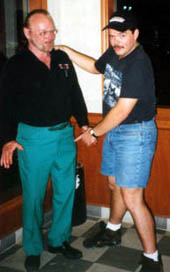
Steve Hooper admires Bob’s green pants. (Courtesy Steve Hooper).
“If you want to know how rich a man is, you merely count his friends.”
Bob’s adventures in wrestling have allowed him to make a wealth of connections, many of them resulting in long-lasting friendships.
John Cozman, 40, has known Bob since he was five years old. His father used to be on the boxing and wrestling commission, so John would tag along to the matches watch Bob announcing. John still remembers his first impressions of Bob.
“His voice,” recalled John. “It was so deep and I always thought that even when I was five how the introductions made the match. And he always used to wear these suede shoes. If he wore green pants, he wore green shoes. If he wore red pants, he wore red shoes. That always stuck out in my mind.”
When John ended up being bitten by the wrestling bug, his friendship with Bob proved pivotal. At the age of 17, he decided he was going to start training as a wrestler by leaving Regina and going down to Walter “Killer” Kowalski’s infamous wrestling school in Boston. Bob sat John down and advised him to train with Stampede great and friend, Archie “The Stomper” Gouldie, a more affordable option that would allow him to train every week when Archie came to Regina, with the occasional trip to Calgary for additional training.
Bob even went so far as to help John order boots and wrestling gear to get him started.
After 21 years, John is still an active professional wrestler in the independent circuit. By day he’s the soft spoken Branch Manager for Securitas Canada. In the ring however, he’s the stern Principal Richard Pound adorned in a suit and tie, carrying a menacing leather strap. And looking on, you’ll see a beaming Bob Leonard.
“He always talks to me after my matches,” revealed John. “We’ve traveled up and down the highway going to shows. Even if Bob doesn’t announce the shows, he’ll go to a show because he likes the business. He will always critique something I’ve done or I’ll ask him. And I appreciate that because it comes from someone that has been around this business and seen everyone there is to see.”
Steve Hooper, known to wrestling fans as referee J. Edgar Hooker, started out as a wrestler and then moved on to being a referee, joking it was too hard to stay in shape. The former west coast and current Stampede official says he’s known “Bobby” since 1997.
“My first impression of him, I thought ‘what a funny old man'” kidded the 35-year-old. “Actually there’s a lot of idiots and backstabbing in this business. Bob is just real and he’s one of the nicest people I’ve ever met.”
Steve resides in Calgary, so whenever Bob is in town, often accompanied by John Cozman, the three of them get together at a local Boston Pizza for their routine “board meetings.”
“I’m of course the chairman of the board,” bragged Steve. “Our board meetings are where we sit around and we solve world hunger and all the problems of the wrestling business.”
The “meetings” have been known to escalate to 3 a.m. and if other wrestlers are invited, shenanigans like picking up the waitresses, as in lifting them, are sure to ensue.
Like John, Steve was also struck by some of the fashions Bob was known to wear. I, myself, always took Bob’s clothes to be another facet of his aura. One day it could be a pink suit, the next day a Hawaiian shirt and pants, the next a distinguished suit and tie. The only constant is his long, grey hair pulled back in a ponytail. He’s always worn it that way.
“We were at a show in Saskatoon and Bob was wearing these awful grass, green pants,” described Steve. “I grabbed the mike from him and yelled, ‘Ladies and gentlemen, how about a round of applause for a very good friend of mine who has been everywhere, done everything, is a legend in this business. And the only man I know with the knackers big enough to wear a pair of green pants like these: Mr. Bob Leonard.’ I still bug him about those.”
But there have been serious moments in their friendship as well. Steve’s favorite memory of Bob has nothing to do with wrestling. It happened when Steve was in Newfoundland and he and his fiancée ended their relationship. On the plane trip back to Calgary, Steve had a stop in Regina, so he called Bob.
“It meant a lot that I just had to pick up the phone and he was there,” he said seriously. “Bob has a really big heart. If you are ever in trouble, he’s there.”
Some of the biggest names in wrestling have had the pleasure of calling Bob their friend.
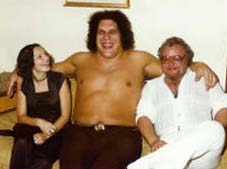
Winnie, Andre the Giant, and Bob Leonard.
And they didn’t get much bigger than Andre the Giant (Andre Rousimoff). At a legitimate 6’11”, though advertised as 7’4″, Andre was a spectacle to most people, but to Bob he was a dear friend and to Bob’s kids, he was Uncle Andre. A frequent visitor to the Leonard home, Andre even danced with Winnie Leonard in the family rumpus room.
Bob and Andre had plenty of good times, going out for drinks and meals, with Andre always insisting that he pick up the tab. That was just his way. His ambition was to live life to the fullest, a motto that has rubbed off on Bob.
“I remember we were sitting in the cocktail lounge of the Regina Inn after the matches talking about ‘life’ and he said, ‘I’ll tell you something Bob,'” offered Bob in his best Andre voice. “‘Right now if I fall down dead off this bar stool, you look down under the bar and say there’s a happy man.’ He put it to me just that way. And boy, I’ve thought of that statement a lot of times.”
Andre passed away on January 27, 1993 at the age of 46, of an apparent heart attack.
That’s the catch with having friends in the wrestling business, the shadow of death shows no mercy. Bob’s had to endure the loss of close friends like Andre, Stu and Helen Hart, Michel Martel (Michel Vigneault), Davey Boy Smith … the list is a long one.
But it was the death of Owen Hart, Stu’s youngest son on May 23, 1999, that is still surreal for Bob.
Because of Bob’s close ties with Stu, he had gotten to know all the Hart children, all 12 of them. His fondest memories are of Owen, who he has known since he was in diapers. He remembers Owen being a sweet kid, but a prankster. On one visit to the massive Hart mansion in Calgary, he recalls finding Owen, who was about three at the time, sitting nonchalantly in the family’s huge restaurant-style oven. On another, Owen was perched mischievously on top of Bob’s Cadillac refusing to get off when it was time for Bob to go home. Bob eventually had to succumb to climbing on top of the car himself to chase Owen down.
The subject of Owen is always bittersweet for me. It is a topic I equally dread and enjoy. This is a time when I know we are going to share a few laughs, but I’m always near tears. Because it’s inevitable how the conversation is going to end.
Every time I meet with Bob, he tells me the story about Owen climbing on top of his Cadillac, but I never stop and tell him this. There’s something about the way his eyes shine, that just makes the story so sacred. Makes it seem like for one moment both of us can pretend that Owen is still here.
Owen died in Kansas City after slipping out of a harness being used to lower him into the ring as part of an entrance stunt.
“That entire week between Kansas City and the funeral, the whole thing has a real surreal quality to it,” commented Bob.
His words come out very slowly and his pauses are frequent.
“And you know oddly anytime I read Terry Funk’s name I have a flashback. When we went into the funeral home, Terry was right behind Winnie and me. And I sort of looked and Terry had this sad, grim look. Every time I see that name, the whole thing comes back. I remember it clearly, but there’s that almost cloudy sense to it.”
* * *
Who is Bob Leonard?
It’s the silliest thing, but I found my answer when I went to Bob’s house.
There was this exquisite Tiffany lamp in his bay window. A kaleidoscope of reds, greens and blues.
I just remember thinking, that’s Bob Leonard.
But instead of stained glass, Bob is comprised of something more valuable. He’s formed by the traits, layers and knowledge of a full life.
A life he wanted.
He’s done this by donning several different hats during his almost 50 years of being involved in what he loves.
And along the way, he found the time to inspire many others: family members, friends, colleagues, aspiring wrestlers, me.
Bob was the first person to offer me acceptance.
He was the first person to say it was okay to like wrestling.
He was one of the first people to recognize and encourage my talent.
Now, I’m not sure where exactly my pen is going to take me, but I’m grateful that I’ve gotten to be a miniscule part of Bob’s life.
Because my life truly started when I met him.
- Jan 9, 2016: Mat Matters: Goodbye and thank you, Bob Leonard
- Nov 28, 2016: Saskatchewan’s gifts to wrestling were Leonard and Cozman
